Time-Varying Efficiency and Economic Shocks: A Rolling DFA Test in Western European Stock Markets
Abstract
1. Introduction
2. Literature Review
3. Methodology
3.1. The Detrended Fluctuation Analysis and Efficiency Index
- -
- When , the time series exhibits no long-range dependence, consistent with the unpredictability of returns and the efficient market hypothesis.
- -
- When , the time series shows positive long-range dependance, indicating persistence or long memory in returns.
- -
- If , the time series displays negative long-range dependance, characterized by a mean-reverting process or anti-persistence.
3.2. Dynamic Approach Using Rolling Windows
4. Empirical Results
4.1. Data
4.2. Statistics Results
5. Discussion
5.1. Persistence and Mean-Reversion Dynamics
5.2. Major Versus Minor Economic Disruption
5.3. Implications for AMH and Fractal Market Hypothesis (FMH)
6. Conclusions
Funding
Data Availability Statement
Conflicts of Interest
Appendix A
| Deutschland | France | UK | The Netherlands | Spain | Italy | Belgium | Switzerland | |
|---|---|---|---|---|---|---|---|---|
| Stock market | DAX | CAC40 | FTSE | AEX | IBEX35 | FTSE MIB | BEL20 | SMI20 |
| Beginning date | 09/02/2001 | 31/03/2001 | 24/01/2001 | 09/04/2001 | 19/01/2001 | 06/03/2001 | 20/02/2001 | 19/01/2001 |
| Ending date | 31/12/2024 | 31/12/2024 | 31/12/2024 | 31/12/2024 | 31/12/2024 | 31/12/2024 | 31/12/2024 | 31/12/2024 |
| Sample | 6075 | 6087 | 6045 | 6086 | 6103 | 6089 | 6110 | 6013 |
| Mean | 1.8083 × 10−4 | 5.9492 × 10−5 | 4.5313 × 10−5 | 7.6389 × 10−5 | 2.4539 × 10−5 | −2.1609 × 10−5 | 5.7543 × 10−5 | 6.3137 × 10−5 |
| Standard deviation | 0.0142 | 0.0138 | 0.0114 | 0.0134 | 0.0140 | 0.0220 | 0.0122 | 0.0112 |
| Maximum | 0.1079 | 0.1059 | 0.0938 | 0.1002 | 0.1348 | 0.8992 | 0.0933 | 0.1078 |
| Minimum | −0.1305 | −0.1309 | −0.1151 | −0.1137 | −0.1515 | −0.8921 | −0.1532 | −0.1013 |
| Kurtosis | 9.40 | 9.97 | 11.66 | 10.77 | 11.63 | 13.95 | 12.90 | 11.06 |
| Skewness | −0.1756 | −0.2064 | −0.3585 | −0.2325 | −0.3138 | −0.7134 | −0.4226 | −0.3010 |
| Jarque–Bera | 10,429 | 12,388 | 19,053 | 15,398 | 19,054 | 30,982 | 25,157 | 16,383 |
Appendix B
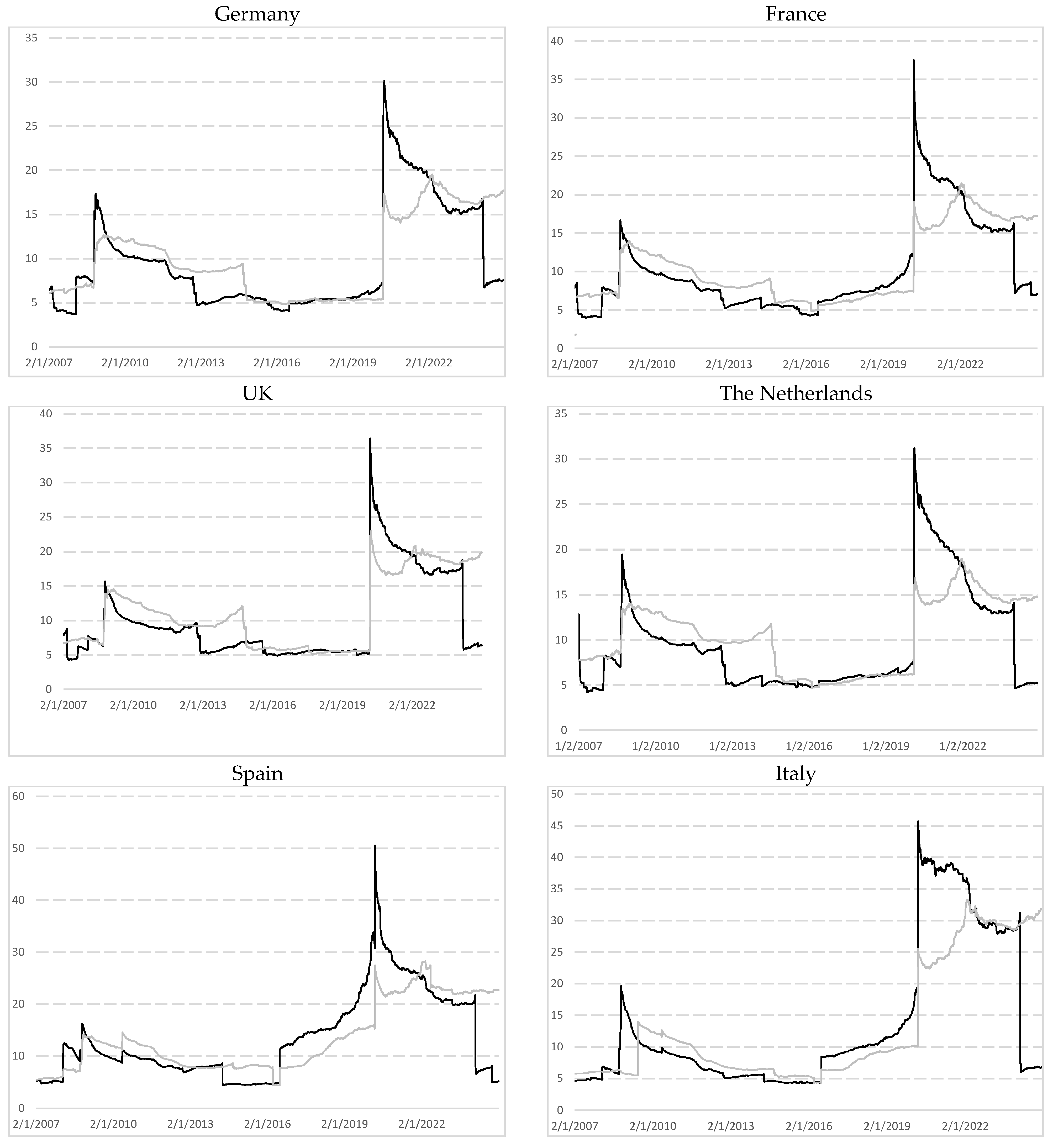

| 1 | With a detrended fluctuation analysis. |
References
- Akhtaruzzaman, M., Boubaker, S., & Sensoy, A. (2021). Financial contagion during COVID-19 crisis. Finance Research Letters, 38, 101604. [Google Scholar] [CrossRef]
- Alvarez-Ramirez, J., Alvarez, J., Rodriguez, E., & Fernandez-Anaya, G. (2008). Time-varying Hurst exponent for US stock markets. Physica A: Statistical Mechanics and its Applications, 387(24), 6159–6169. [Google Scholar] [CrossRef]
- Ammy-Driss, A., & Garcin, M. (2021). Efficiency of the financial markets during the COVID-19 crisis: Time-varying parameters of fractional stable dynamics. arXiv, arXiv:2007.10727v3. [Google Scholar] [CrossRef]
- Asif, R., & Frömmel, M. (2022). Testing long memory in exchange rates and its implications for the Adaptive Market Hypothesis. Physica A: Statistical Mechanics and Its Applications, 593, 126871. [Google Scholar] [CrossRef]
- Aslam, F., Ferreira, P., & Mohti, W. (2021). Investigating efficiency of frontier stock markets using multifractal Detrended Fluctuation Analysis. International Journal of Emerging Markets, 18(7), 1650–1676. [Google Scholar] [CrossRef]
- Aslam, F., Nogueiro, F., Brasil, M., Ferreira, P., Mughal, K. S., Bashir, B., & Latif, S. (2020). The footprints of COVID-19 on Central Eastern European stock markets: An intraday analysis. Post-Communist Economies, 33(6), 751–769. [Google Scholar] [CrossRef]
- Balcilar, M., Bekiros, S., & Gupta, R. (2017). The role of news-based uncertainty indices in predicting oil markets: A hybrid nonparametric quantile causality method. Empirical Economics, 53(3), 879–889. [Google Scholar] [CrossRef]
- Boya, C. (2017). Testing capital market efficiency. Global Business and Economics Review, 19(2), 194–224. [Google Scholar] [CrossRef]
- Boya, C. (2019). From efficient markets to adaptive markets: Evidence from the French stock exchange. Research in International Business and Finance, 49, 156–165. [Google Scholar] [CrossRef]
- Boya, C. (2023). Testing the adaptive market hypothesis through the presence of dependence in the Swiss stock exchange. Applied Economics Quarterly. Forthcoming. [Google Scholar]
- Cajueiro, D. O., & Tabak, B. M. (2004). The Hurst exponent over time: Testing the assertion that emerging markets are becoming more efficient. Physica A: Statistical Mechanics and Its Applications, 336, 521–537. [Google Scholar] [CrossRef]
- Da Silva, S., Figueiredo, A., Gleria, I., & Matsushita, R. (2007). Hurst exponents, power laws, and efficiency in the Brazilian foreign exchange market. Economics Bulletin, 7, 1–11. [Google Scholar]
- Engelen, S., Norouzzadeh, P., Dullaert, W., & Rahmani, B. (2011). Multifractal features of spot rates in the Liquid Petroleum Gas shipping market. Energy Economics, 33, 88–98. [Google Scholar] [CrossRef]
- Fama, E. F. (1970). Efficient capital markets: A review of theory and empirical work. Journal of Finance, 25, 383–417. [Google Scholar] [CrossRef]
- Ferreira, P. (2018). Long-range dependence of eastern European stock markets: A dynamic detrended analysis. Physica A: Statistical Mechanics and Its Applications, 505, 454–470. [Google Scholar]
- Ferreira, P. (2020). Dynamic long-range dependences in the Swiss stock market. Empirical Economics, 58, 1541–1573. [Google Scholar] [CrossRef]
- Grech, M., & Mazur, Z. (2004). Can one make any crash prediction in finance using the local hurst exponent idea? Physica A: Statistical Mechanism and Its Applications, 336(1), 133–145. [Google Scholar]
- Hiremath, G. S., & Narayan, S. (2016). Testing the adaptive market hypothesis and its determinants for the Indian stock markets. Finance Research Letters, 19, 173–180. [Google Scholar] [CrossRef]
- Horta, P., Lagoa, S., & Martins, L. (2014). The impact of the 2008 and 2010 financial crises on the Hurst exponents of international stock markets: Implications for efficiency and contagion. International Review of Financial Analysis, 35, 140–153. [Google Scholar] [CrossRef]
- Hurst, H. E. (1951). Long term storage capacity of reservoirs. Transactions of the American Society of Civil Engineers, 116, 770–799. [Google Scholar] [CrossRef]
- Kantelhardt, J. W., Zschiegner, S. A., Koscielny-Bunde, E., Havlin, S., Bunde, A., & Stanley, H. E. (2002). Multifractal Detrended Fluctuation Analysis of nonstationary time series. Physica A: Statistical Mechanics and Its Applications, 316, 87–114. [Google Scholar] [CrossRef]
- Kim, J. H., Shamsuddin, A., & Lim, K. P. (2011). Stock return predictability and the Adaptive Markets Hypothesis: Evidence from century-long U.S. data. Journal of Empirical Finance, 18, 868–879. [Google Scholar] [CrossRef]
- Kristoufek, L. (2010). Rescaled range analysis and detrended fluctuation analysis: Finite sample properties and confidence intervals. Czech Economic Review, 4(3), 315–329. [Google Scholar]
- Kristoufek, L. (2012). Fractal markets hypothesis and the global financial crisis: Scaling, investment horizons and liquidity. Advances in Complex Systems, 15, 1–7. [Google Scholar] [CrossRef]
- Kristoufek, L. (2013). Fractal markets hypothesis and the global financial crisis: Wavelet power evidence. Scientific Reports, 3, 2857. [Google Scholar] [CrossRef]
- Kristoufek, L., & Vosvrda, M. (2013a). Measuring capital market efficiency: Global and local correlations structure. Physica A: Statistical Mechanics and Its Applications, 392, 184–193. [Google Scholar]
- Kristoufek, L., & Vosvrda, M. (2013b). Measuring capital market efficiency: Long-term memory, fractal dimension and approximate entropy. Euoprean Physcial Journal B, 87, 162. [Google Scholar] [CrossRef]
- Kumar, S., & Deo, N. (2013). Analyzing crisis in global financial indices. In Econophysics of systemic risk and network dynamics. Springer. [Google Scholar]
- Lo, A. W. (2004). The adaptive markets hypothesis: Market efficiency from an evolutionary perspective. Journal of Portfolio Management, 30, 15–29. [Google Scholar]
- Lo, A. W. (2005). Reconciling efficient markets with behavioral finance: The Adaptive Markets Hypothesis. Journal of Investment Consulting, 7, 21–44. [Google Scholar]
- Lo, A. W., & MacKinlay, A. C. (1988). stock market prices do not follow random walks: Evidence from a simple specification test. Review of Financial Studies, 1, 41–66. [Google Scholar] [CrossRef]
- Ma, P., Li, D., & Li, S. (2016). Efficiency and cross-correlation in equity market during global financial crisis: Evidence from China. Physica A, 444, 163–176. [Google Scholar] [CrossRef]
- Mandelbrot, B. B. (1972). Statistical methodology for non-periodic cycles: From the covariance to R/S analysis. Annals of Economic and Social Measurement, 3, 543–553. [Google Scholar]
- Matos, J. M. O., de Moura, E. P., Krüger, S. E., & Rebello, J. M. A. (2004). Rescaled range analysis and Detrended Fluctuation Analysis study of cast iron ultrasonic backscattered signals. Chaos, Solitons and Fractals, 19(1), 55–60. [Google Scholar] [CrossRef]
- Morales, R., Di Matteo, T., Gramatica, R., & Aste, T. (2012). Dynamical generalized Hurst exponent as a tool to monitor unstable periods in financial time series. Physica A: Statistical Mechanics and Its Applications, 391, 3180–3189. [Google Scholar]
- Ozkan, O. (2021). Impact of COVID-19 on stock market efficiency: Evidence from developed countries. Research in International Business and Finance, 58, 101445. [Google Scholar] [CrossRef]
- Peng, C.-K., Buldyrev, S. V., Havlin, S., Simons, M., Stanley, H. E., & Goldberger, A. L. (1994). Mosaic organization of DNA nucleotides. Physical Review E, 49(2), 1685–1689. [Google Scholar] [CrossRef]
- Peters, E. E. (1994). Fractal market analysis: Applying chaos theory to investment and economics. Wiley & Sons, Inc. [Google Scholar]
- Rogério, L., Costa, L., & Vasconcelos, G. (2003). Long-range correlations and nonstationarity in the Brazilian stock market. Physica A: Statistical Mechanics and Its Applications, 329, 231–248. [Google Scholar]
- Sensoy, A., & Tabak, B. M. (2016). Dynamic efficiency of stock markets and exchange rates. International Review of Financial Analysis, 47, 353–371. [Google Scholar] [CrossRef]
- Soteriou, A., & Svensson, L. (2017). Testing the adaptive market hypothesis on the OMXS30 stock index: 1986–2014 [Master’s thesis, Jönköping University]. [Google Scholar]
- Takaishi, T. (2022). Time evolution of market efficiency and multifractality of the Japanese stock market. Risk and Financial Management, 15, 31. [Google Scholar] [CrossRef]
- Tripathi, A., Vipul, V., & Dixit, A. (2020). Adaptive market hypothesis and investor sentiments: Global evidence. Managerial Finance, 46, 1407–1436. [Google Scholar] [CrossRef]
- Urquhart, A., & Hudson, R. (2013). Efficient or adaptive markets? Evidence from major stock markets using very long run historic data. International Review of Financial Analysis, 28, 130–142. [Google Scholar] [CrossRef]
- Urquhart, A., & McGroarty, F. (2016). Are stock markets really efficient? Evidence of the Adaptive Market Hypothesis. International Review of Financial Analysis, 47, 39–49. [Google Scholar] [CrossRef]
- Zhang, B., Li, X., & Yu, H. (2013). Has recent financial crisis changed permanently the correlations between BRICS and developed stock markets? The North American Journal of Economics and Finance, 26, 725–738. [Google Scholar] [CrossRef]
- Zhang, D., Hu, M., & Ji, Q. (2020). Financial markets under the global pandemic of COVID-19. Finance Research Letters, 36, 1–6. [Google Scholar] [CrossRef]
- Zunino, L., Tabak, B. M., Pérez, D. G., Garavaglia, M., & Rosso, O. A. (2009). Inefficiency in Latin-American market indices. European Physical Journal B, 67(3), 369–379. [Google Scholar] [CrossRef]
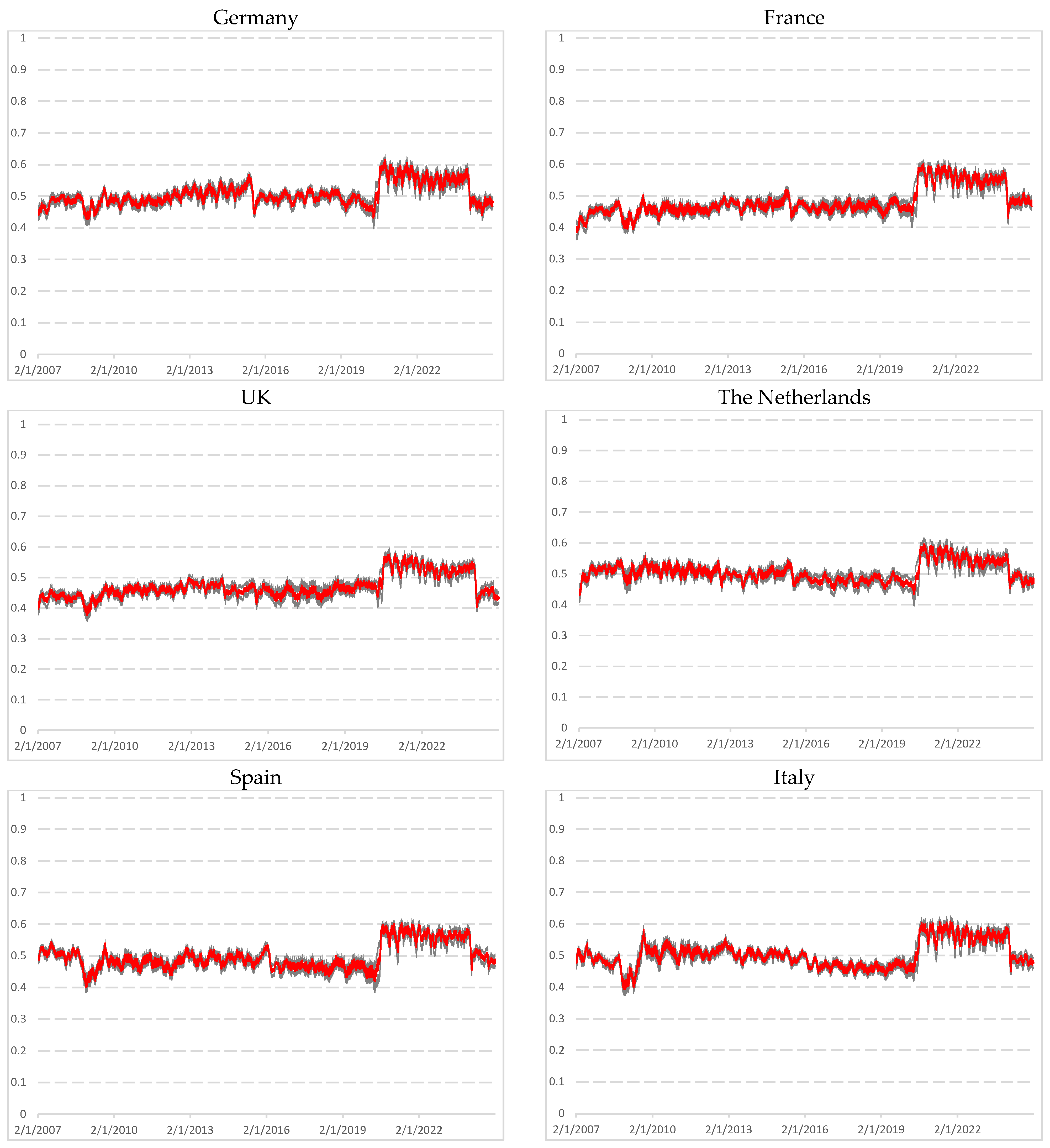
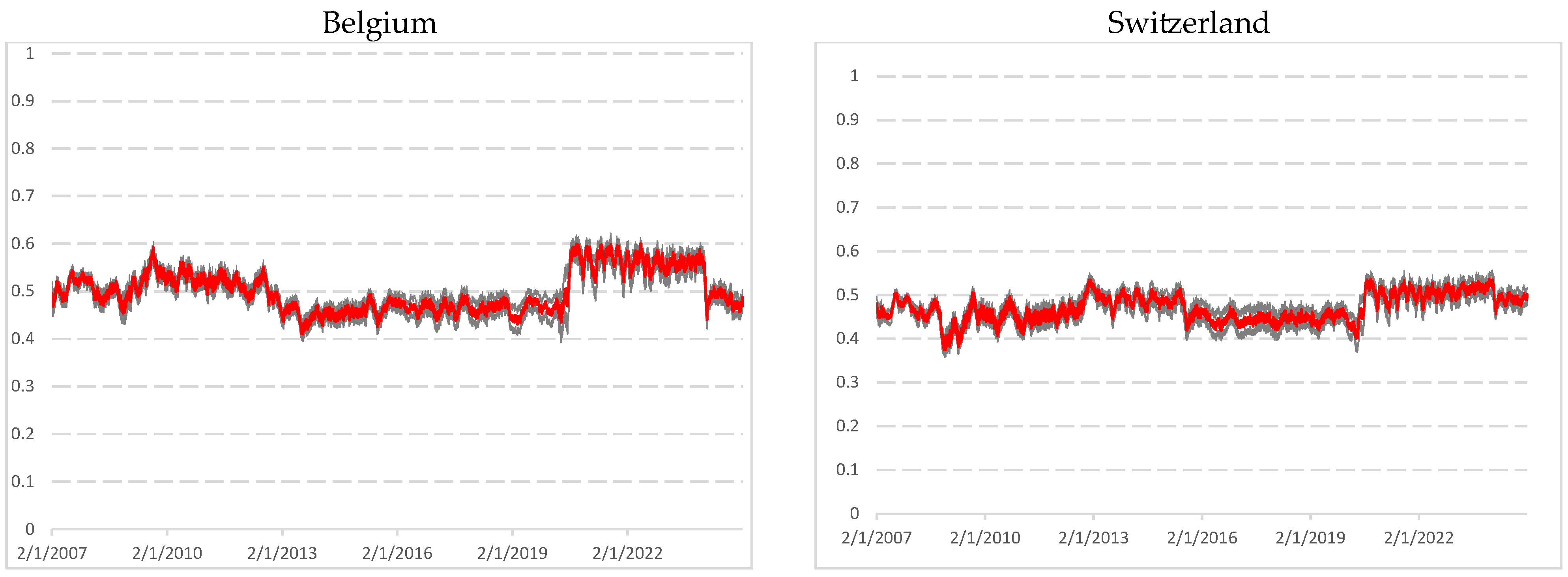
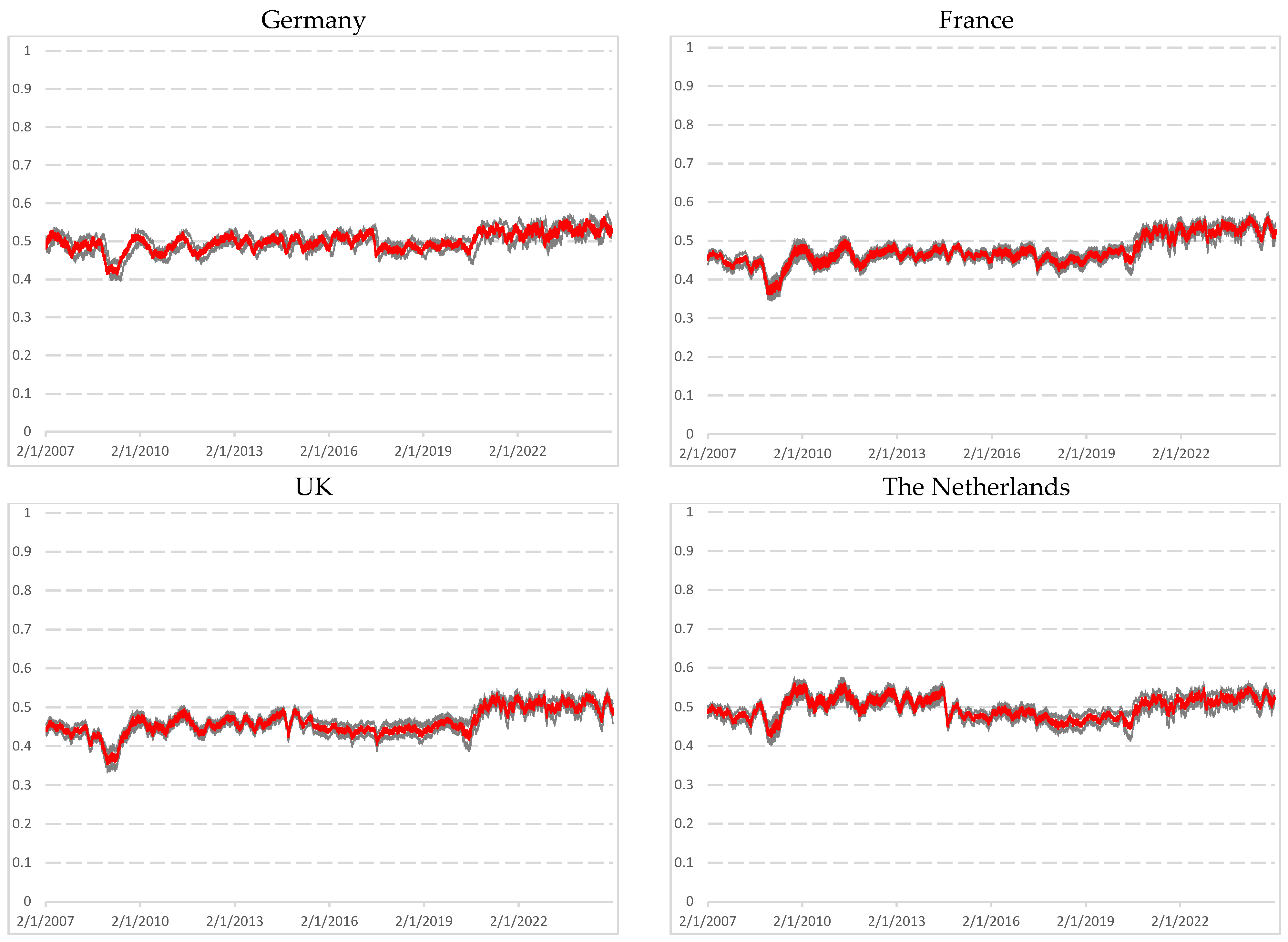


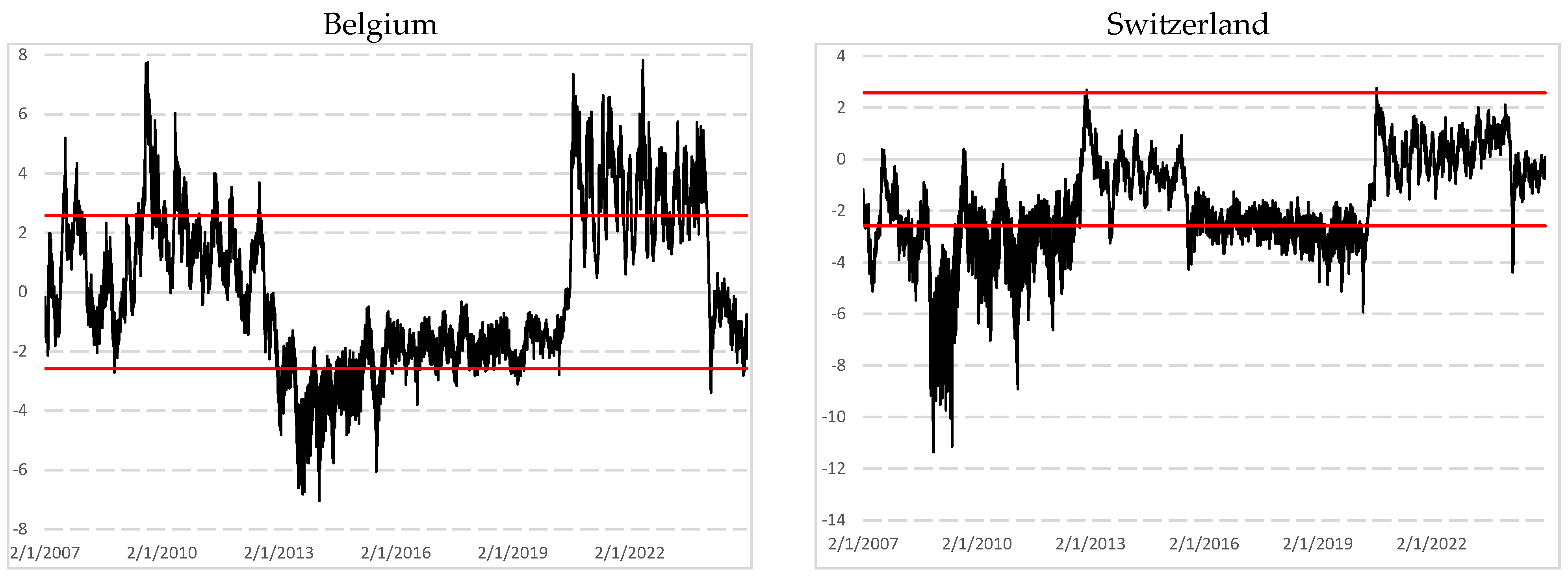

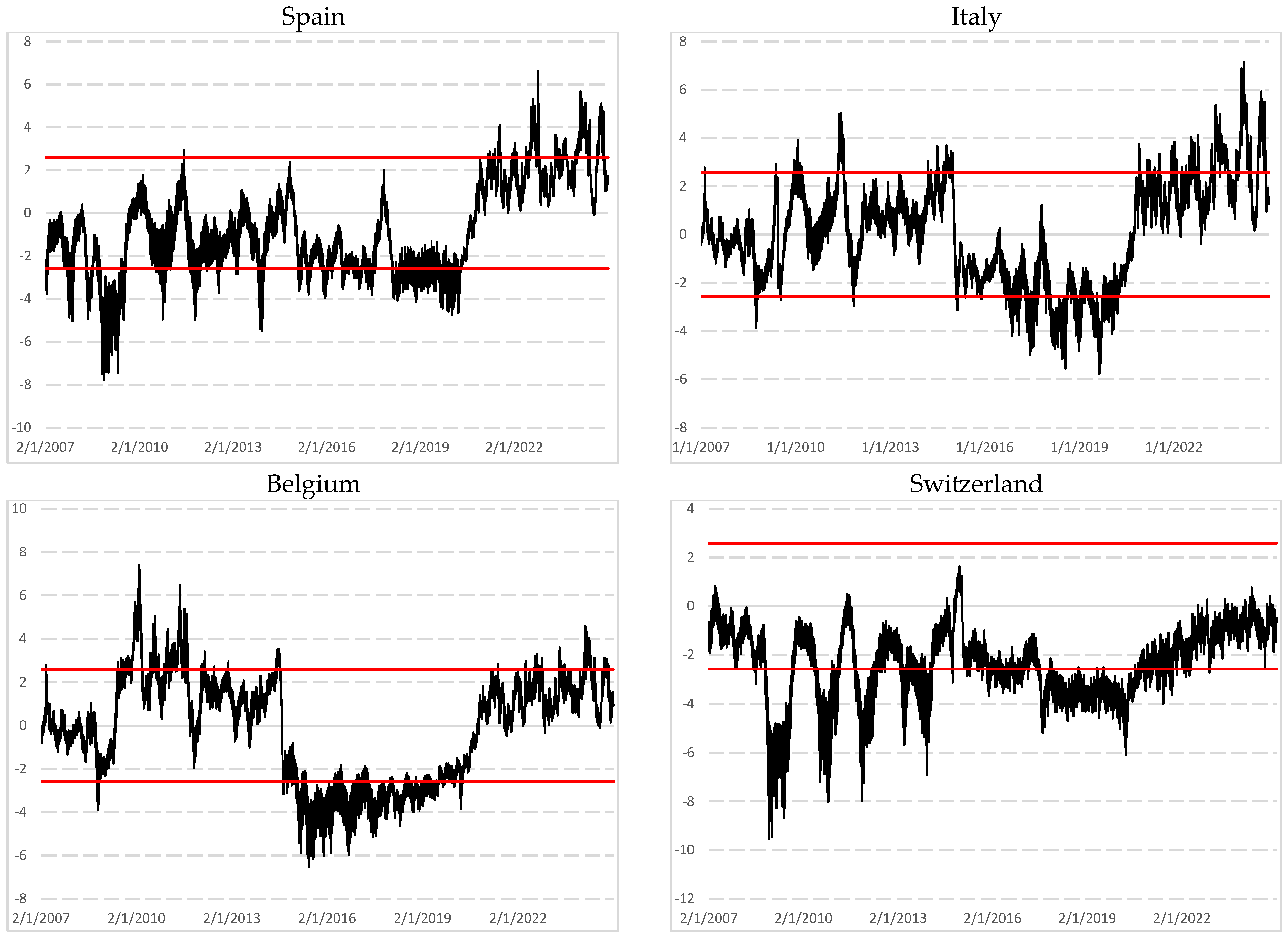
| Length w = 1000 | Length w = 1500 | ||
|---|---|---|---|
| Country | Market | Efficiency Index | Efficiency Index |
| Germany | DAX | 0.049209386 | 0.034648195 |
| France | CAC40 | 0.066789795 | 0.063333729 |
| UK | FTSE100 | 0.066885262 | 0.070862304 |
| The Netherlands | AEX | 0.043353629 | 0.037470596 |
| Spain | IBEX35 | 0.057830142 | 0.045728394 |
| Italy | FTSEMIB | 0.059079976 | 0.040037193 |
| Belgium | BEL20 | 0.060448544 | 0.053541813 |
| Switzerland | SMI20 | 0.061286285 | 0.06610842 |
| Markets | COVID-19 Pandemic (2020–2022) | Ukraine—Russia War (2022–Nowadays) |
|---|---|---|
| Germany | Strong persistence, long-range dependence for all window sizes Peak of kurtosis | Moderate persistence, delayed return toward efficiency Strong decreasing kurtosis |
| France | Strong persistence, long-range dependence for all window sizes Peak of kurtosis | Moderate persistence, delayed return toward efficiency Strong decreasing kurtosis |
| UK | Strong persistence, moderate long memory (w = 1000) Few peaks of persistence for larger window sizes Peak of kurtosis | Gradual recovery to efficiency (w = 1000) Market remains efficient (w = 1500) Strong decreasing kurtosis |
| The Netherlands | Strong persistence, moderate long memory Peak of kurtosis | Moderate persistence, delayed return toward efficiency Strong decreasing kurtosis |
| Spain | Strong persistence, long-range dependence for all window sizes Peak of kurtosis | Moderate persistence, delayed return toward efficiency Strong decreasing kurtosis |
| Italy | Strong persistence, long-range dependence for all window sizes Peak of kurtosis | Moderate persistence, delayed return toward efficiency Strong decreasing kurtosis |
| Belgium | Strong persistence, moderate long memory (w = 1000) Few peaks of persistence for larger window sizes Peak of kurtosis | Moderate persistence, delayed return toward efficiency Strong decreasing kurtosis |
| Switzerland | A peak of long memory (w = 1000) Market then remains efficient Peak of kurtosis | Market remains efficient for all windows sizes Strong decreasing kurtosis |
| Market | Subprime Crisis (2008–2009) | Sovereign Debt Crisis (2010–2012) | Inflation and Rise Interest Rates (2022–2024) |
|---|---|---|---|
| Germany | Mean-reverting behavior, sharp anti-persistence Peak of kurtosis | Anti-persistence close to lower bound Clear mean-reverting for w = 1500 Decreasing kurtosis | Moderate persistence, delayed return toward efficiency Strong decreasing kurtosis |
| France | Strong mean-reverting behavior Peak of kurtosis | Strong mean-reverting behavior Decreasing kurtosis | Moderate persistence, delayed return toward efficiency Strong decreasing kurtosis |
| UK | Strong mean-reverting behavior Peak of kurtosis | Strong mean-reverting behavior Decreasing kurtosis | Persistence for w = 1000 Market remains efficient Strong decreasing kurtosis |
| The Netherlands | Mostly efficient for w = 1000 and peaks of long-memory Spikes of mean-reverting for w = 1500 Peak of kurtosis | Presence of long-range dependence Decreasing kurtosis | Moderate persistence, delayed return toward efficiency Strong decreasing kurtosis |
| Spain | Strong anti-persistence, clear mean-reversion Peak of kurtosis | Pronounced anti-persistence Peak of kurtosis | Moderate persistence, delayed return toward efficiency Strong decreasing kurtosis |
| Italy | Strong mean-reversion Few peaks of anti-persistence for w = 1500 Peak of kurtosis | Discrepancies between bounds Presence of long-range dependence Decreasing kurtosis | Moderate persistence, delayed return toward efficiency Strong decreasing kurtosis |
| Belgium | Few peaks of anti-persistence Peak of kurtosis | Discrepancies between bounds Presence of long-range dependence Decreasing kurtosis | Moderate persistence, delayed return toward efficiency Strong decreasing kurtosis |
| Switzerland | Strong mean-reverting behavior Peak of kurtosis | Strong mean-reverting behavior Decreasing kurtosis | Stability throughout the period Strong decreasing kurtosis |
Disclaimer/Publisher’s Note: The statements, opinions and data contained in all publications are solely those of the individual author(s) and contributor(s) and not of MDPI and/or the editor(s). MDPI and/or the editor(s) disclaim responsibility for any injury to people or property resulting from any ideas, methods, instructions or products referred to in the content. |
© 2025 by the author. Licensee MDPI, Basel, Switzerland. This article is an open access article distributed under the terms and conditions of the Creative Commons Attribution (CC BY) license (https://creativecommons.org/licenses/by/4.0/).
Share and Cite
Boya, C.M. Time-Varying Efficiency and Economic Shocks: A Rolling DFA Test in Western European Stock Markets. Int. J. Financial Stud. 2025, 13, 157. https://doi.org/10.3390/ijfs13030157
Boya CM. Time-Varying Efficiency and Economic Shocks: A Rolling DFA Test in Western European Stock Markets. International Journal of Financial Studies. 2025; 13(3):157. https://doi.org/10.3390/ijfs13030157
Chicago/Turabian StyleBoya, Christophe Musitelli. 2025. "Time-Varying Efficiency and Economic Shocks: A Rolling DFA Test in Western European Stock Markets" International Journal of Financial Studies 13, no. 3: 157. https://doi.org/10.3390/ijfs13030157
APA StyleBoya, C. M. (2025). Time-Varying Efficiency and Economic Shocks: A Rolling DFA Test in Western European Stock Markets. International Journal of Financial Studies, 13(3), 157. https://doi.org/10.3390/ijfs13030157






